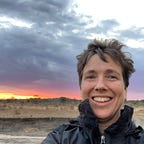My Cadaver Had a First Name: Dear John
1988, Portland, Oregon
My first glimpse of Dear John was the strangest. I was nervous and had to hold back the urge to burst into my long-forgotten uncontrolled teenage girl giddiness. Mostly I was in shock of finding myself in the room. With each passing session, I learned to tame my immature reactions while the exploration and learning blossomed. Dear John, thank you for your foresight.
9 months later
It was a late Saturday afternoon in May. I walked briskly down the sidewalk of our private college campus, nestled in a suburb of eastern Portland. Parallel lines of light were crossing the grassy lawns. This was the last time I could get into the gross anatomy lab to review for the practical exam on Monday.
Nobody was around. It felt almost too quiet for comfort. My eyes scanned the landscaped gardens as I approached the small building on the back side of the gymnasium, where I found the door unlocked, as anticipated. Once inside I set down my bag and pulled out my face mask. I put it on and took one of the dark green plastic aprons hanging on the coat rack, as well as a pair of extra small latex gloves from a box on the adjacent shelf and continued prepping myself.
Once dressed, I went over to the walk-in refrigerator where the bodies were stored. I pulled hard to open one side of the paired doors, and the dim yellow light came on simultaneously. Entering the chilling room, a faint whiff of formaldehyde was still detectable through my mask. Ugh, I detested this reeking stench. The solid metal door clanged closed behind me. Good thing I had rehearsed this “open lab” routine with study buddies, many times prior.
I began my search, lifting stained, dingy cotton draperies. There must have been 12, maybe 15 gurneys lined up on both sides of the room. A peek was more than enough. Or at least all I wanted to tolerate.
Only I called him “Dear John.” He was taller and bigger than most of the others. I often wondered about his life. Maybe a dairy farmer and seemingly having died before his time. His husky muscular form had changed a lot by this point in our studies, but not in my mind. I saw him as an intelligent, compassionate human being coming from a lifetime of physical work, from a family who valued a strong work ethic.
We, a team of six, took the journey through his body in layers; skin, fat, fascia, muscle, tendons, ligaments and bone. We went systematically through each organ system, finding and identifying special features, significant tissue changes, circulatory routes and key innervations.
Our dissecting and identifying skills sharpened with every cut and scrape of the scalpel. By this point in time, the outer layers of Dear John were gone. All of the covered bodies looked more like a kill in the Serengeti after the family of lions, vultures and hyenas had feasted in proper succession. However, upon more careful inspection, one could see meticulously cleaned muscles still intact at both origins and insertions interlaced by nerves hanging like delicate single strands of linguine, or more likely, solo capellini.
Subtle signs would help me to recognize him from the others. Maybe the thickness of his latex-filled subclavian artery or even the lack of yellow bubbly shiny fat around his heart? Any sign would do, but it had to be him. It was not good enough to borrow just any other body in the room and go out. The others were strangers to me. Dear John was the one we had worked on for the previous nine months, the one I knew the best and for whom I had even invented a friendly charming personality.
Fervently looking, I heard myself saying, “Is that you, John?” Several minutes of intent searching went by, when suddenly a surge of fear arose, waking me out of my trance. The scenario became momentarily unreal. I could feel the hair on my arms stand up followed by a shiver. I creeped myself out, sensing both suffocation and panic. Fortunately, in the following moment, I saw an identifying feature of John’s cranium and the hunt was over. I gave a hard tug to get the gurney rolling and headed out. The yellow light flickered as I pressed hard on the door handle and we moved out into the light.
The following autumn I experienced a similar bizarre moment. I found myself once again alone in a laboratory classroom to study neuroanatomy. Only this time, instead of an entire cadaver, it was a human brain.
I opened the lid of the Tupperware bowl and gently held the brain in my gloved hands. Stunned and spaced, I contemplated the notion that I was holding what was once the key operating system of an entire life. Once upon a time, neurons fired, movements were learned, language was acquired, memories were stored, signals were interpreted and all had meaning. Momentarily, the identified “I” was lost. How was it possible? Use of one brain to understand the other, but only one was alive: mine.
